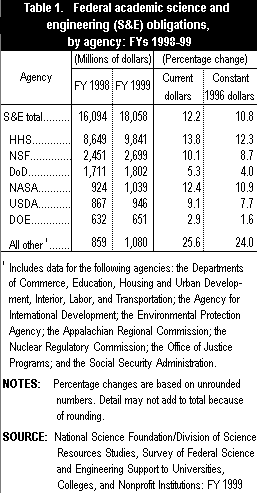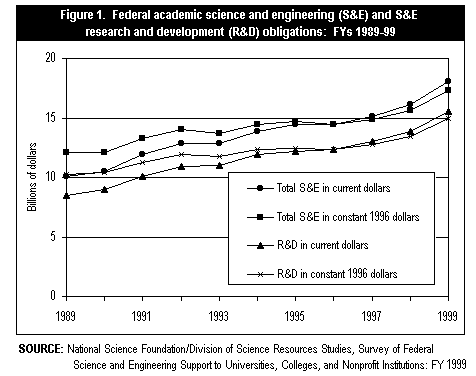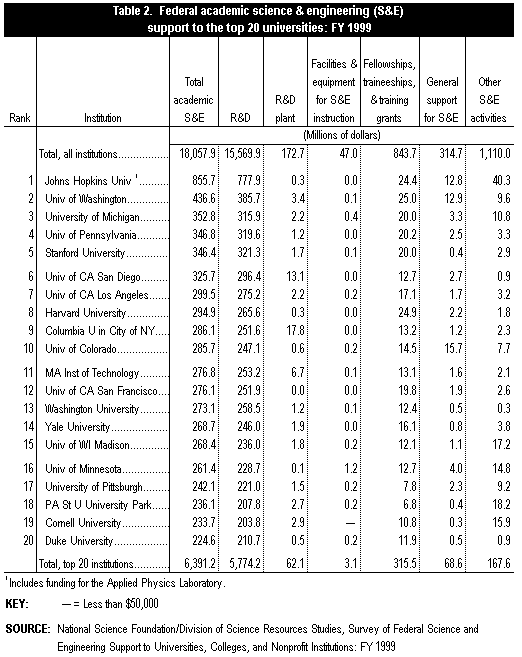Division of Science Resources Studies |
|
 |
Directorate for
Social, Behavioral and Economic Sciences |
|
|
|
National Science Foundation
|
NSF 01-321, March 20, 2001
|
Federal Academic Science and Engineering Obligations Increased More Than 12 Percent Between FY 1998 and FY 1999
Richard J. Bennof
Federal obligations reached a new high of $15.6 billion for academic research and development in FY 1999.
Johns Hopkins University continued as the leading university recipient of Federal academic S&E support.
Federal agencies obligated a new high of $18.1 billion for academic science and engineering (S&E) activities in fiscal year (FY) 1999—up more than 12 percent over FY 1998 (or just under $2 billion), or 11 percent when adjusted for inflation. The absolute dollar increase is a new record. The increase follows a 7-percent current-dollar increase (5 percent in constant dollars) in total Federal academic S&E support between FYs 1997 and 1998. This information is based on the latest statistics from the National Science Foundation's (NSF's) annual Survey of Federal Science and Engineering Support to Universities, Colleges, and Nonprofit Institutions.
Categories of Support and Agency Sources
Federal support for academic S&E activities funds six categories:
- research and development (R&D);
- fellowships, traineeships, and training grants (FTTG);
- R&D plant;
- facilities and equipment for S&E instruction;
- general support for S&E. Such programs can include either support provided without any specification of purpose other than that the funds be used for scientific projects or support for activities within a specified discipline but without specification of explicit purpose.
- other S&E activities. This category encompasses all academic S&E obligations that cannot be assigned elsewhere and includes activities in support of technical conferences, teacher institutes, and programs aimed at increasing the scientific knowledge of precollege and undergraduate students.
The Department of Health and Human Services (HHS) accounted for over 54 percent ($9.8 billion) of all Federal FY 1999 academic S&E obligations. When combined with the other five Federal agencies that accounted for the largest amounts of academic S&E obligations [NSF, the National Aeronautics and Space Administration (NASA), the Department of Defense (DoD), the Department of Agriculture (USDA), and the Department of Energy (DOE)], those Federal agencies provided 94 percent of total FY 1999 Federal academic S&E funding (table 1). S&E funds obligated by each of these six agencies grew in current-dollars at rates ranging between 3 and 14 percent.
Federal academic S&E support primarily funds R&D projects, which have accounted for 84 to 86 percent of the total throughout the 1990s (figure 1). A new high of $15.6 billion was reached in this category in FY 1999, representing more than a 12-percent current-dollar increase—and an 11-percent increase in real dollars—over the previous year. HHS accounted for 58 percent ($9.1 billion) of all Federal academic R&D obligations in FY 1999 and nearly two-thirds of the total R&D increase.
Each of the other funding categories also showed increases in both current and real dollars. Fellowships, traineeships, and training grant support rose over 11 percent in current dollars to a new high of $844 million; HHS was the source of 79 percent of this increase. Federal obligations for R&D plant increased by 10 percent to $173 million, largely from National Institutes of Health (NIH) (part of HHS) programs. Funds for facilities and equipment for instruction more than doubled to a level of $47 million; most of the increase was from DoD programs. Obligations for general support projects totaled a new high of $315 million in FY 1999, a 32-percent rise stemming mostly from increased support from the National Oceanic and Atmospheric Administration (NOAA) (part of the Department of Commerce) and from HHS. Funds for other S&E activities increased over 6 percent to a new high of $1.1 billion; most of this increase was supplied by the Department of Education and by NSF.
University Shares
The Johns Hopkins University (including its Applied Physics Laboratory) continued to be the leading academic recipient of Federal S&E support in FY 1999 (table 2), with HHS and DoD together providing 83 percent of its Federal S&E funds. Just over $9 out of every $10 in the university's $856 million total S&E obligations supported R&D programs, with most of the remainder allocated to other S&E activities. The top 20 universities, ranked by Federal academic S&E obligations, accounted for 35 percent of the total. All but one of the top 20 recipients in FY 1999 were also among the leading 20 universities in FY 1998. The new entrant was Pennsylvania State University (18th after being 22nd the previous year); it replaced the University of North Carolina at Chapel Hill (22nd after being 19th).
User Notes
The Federal academic S&E obligations data presented in this Data Brief were obtained from 18 agencies that participated in the FY 1999 Survey of Federal Science and Engineering Support to Universities, Colleges, and Nonprofit Institutions. Data from this annual survey allow Federal S&E support to be reported by funding agency, type of institution, institutional ranking, and geographic distribution.
NSF makes available computer-generated Institutional Profiles for individual doctorate-granting institutions and schools with S&E departments that grant master's degrees. These profiles contain data from this survey and from NSF's other two academic S&E surveys: the Survey of Academic Research and Development Expenditures, and the Survey of Graduate Students and Postdoctorates in Science and Engineering. Data from the three surveys are also available via the World Wide Web (see "Electronic Dissemination," p.1) and the Computer-Aided Science Policy Analysis and Research (WebCASPAR) database system, a user-friendly Web tool for retrieval and analysis of statistical data on academic S&E resources.
For more information about this Data Brief contact:
Richard J. Bennof
Division of Science Resources Studies
National Science Foundation
4201 Wilson Boulevard, Suite 965
Arlington, VA 22230
703-292-7783
rbennof@nsf.gov


